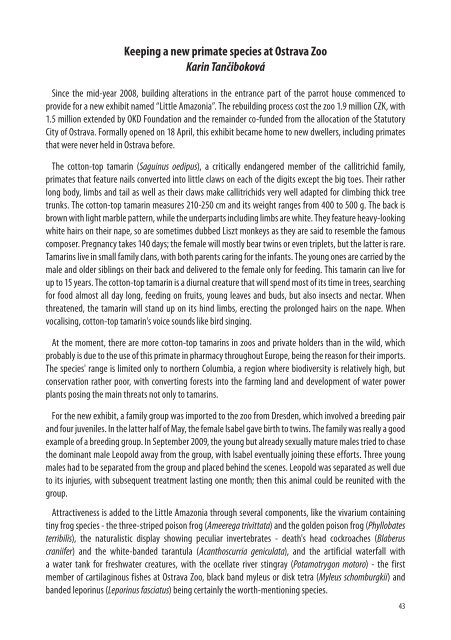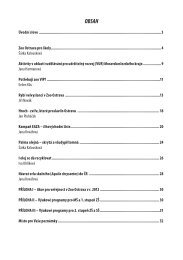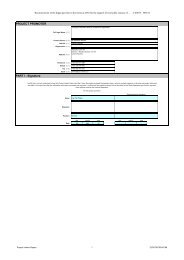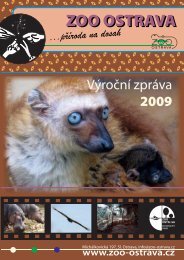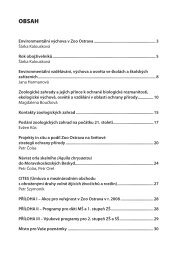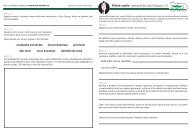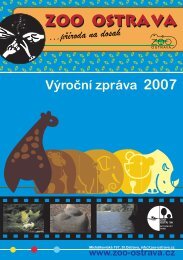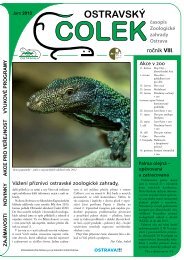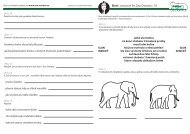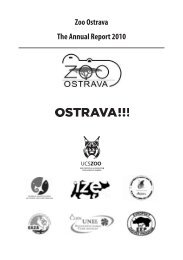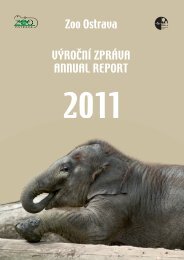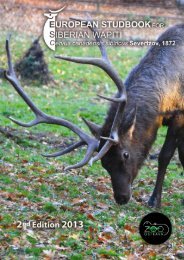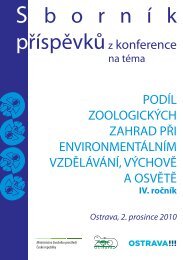Create successful ePaper yourself
Turn your PDF publications into a flip-book with our unique Google optimized e-Paper software.
Keeping a new primate species at <strong>Ostrava</strong> <strong>Zoo</strong><br />
Karin Tančiboková<br />
Since the mid-year 2008, building alterations in the entrance part of the parrot house commenced to<br />
provide for a new exhibit named “Little Amazonia”. <strong>The</strong> rebuilding process cost the zoo 1.9 million CZK, with<br />
1.5 million extended by OKD Foundation and the remainder co-funded from the allocation of the Statutory<br />
City of <strong>Ostrava</strong>. Formally opened on 18 April, this exhibit became home to new dwellers, including primates<br />
that were never held in <strong>Ostrava</strong> before.<br />
<strong>The</strong> cotton-top tamarin (Saguinus oedipus), a critically endangered member of the callitrichid family,<br />
primates that feature nails converted into little claws on each of the digits except the big toes. <strong>The</strong>ir rather<br />
long body, limbs and tail as well as their claws make callitrichids very well adapted for climbing thick tree<br />
trunks. <strong>The</strong> cotton-top tamarin measures 210-250 cm and its weight ranges from 400 to 500 g. <strong>The</strong> back is<br />
brown with light marble pattern, while the underparts including limbs are white. <strong>The</strong>y feature heavy-looking<br />
white hairs on their nape, so are sometimes dubbed Liszt monkeys as they are said to resemble the famous<br />
composer. Pregnancy takes 140 days; the female will mostly bear twins or even triplets, but the latter is rare.<br />
Tamarins live in small family clans, with both parents caring for the infants. <strong>The</strong> young ones are carried by the<br />
male and older siblings on their back and delivered to the female only for feeding. This tamarin can live for<br />
up to 15 years. <strong>The</strong> cotton-top tamarin is a diurnal creature that will spend most of its time in trees, searching<br />
for food almost all day long, feeding on fruits, young leaves and buds, but also insects and nectar. When<br />
threatened, the tamarin will stand up on its hind limbs, erecting the prolonged hairs on the nape. When<br />
vocalising, cotton-top tamarin's voice sounds like bird singing.<br />
At the moment, there are more cotton-top tamarins in zoos and private holders than in the wild, which<br />
probably is due to the use of this primate in pharmacy throughout Europe, being the reason for their imports.<br />
<strong>The</strong> species' range is limited only to northern Columbia, a region where biodiversity is relatively high, but<br />
conservation rather poor, with converting forests into the farming land and development of water power<br />
plants posing the main threats not only to tamarins.<br />
For the new exhibit, a family group was imported to the zoo from Dresden, which involved a breeding pair<br />
and four juveniles. In the latter half of May, the female Isabel gave birth to twins. <strong>The</strong> family was really a good<br />
example of a breeding group. In September <strong>2009</strong>, the young but already sexually mature males tried to chase<br />
the dominant male Leopold away from the group, with Isabel eventually joining these efforts. Three young<br />
males had to be separated from the group and placed behind the scenes. Leopold was separated as well due<br />
to its injuries, with subsequent treatment lasting one month; then this animal could be reunited with the<br />
group.<br />
Attractiveness is added to the Little Amazonia through several components, like the vivarium containing<br />
tiny frog species - the three-striped poison frog (Ameerega trivittata) and the golden poison frog (Phyllobates<br />
terribilis), the naturalistic display showing peculiar invertebrates - death's head cockroaches (Blaberus<br />
craniifer) and the white-banded tarantula (Acanthoscurria geniculata), and the artificial waterfall with<br />
a water tank for freshwater creatures, with the ocellate river stingray (Potamotrygon motoro) - the first<br />
member of cartilaginous fishes at <strong>Ostrava</strong> <strong>Zoo</strong>, black band myleus or disk tetra (Myleus schomburgkii) and<br />
banded leporinus (Leporinus fasciatus) being certainly the worth-mentioning species.<br />
43


